Benedicts test Study guides, Revision notes & Summaries
Looking for the best study guides, study notes and summaries about Benedicts test? On this page you'll find 110 study documents about Benedicts test.
All 110 results
Sort by
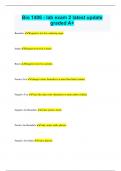
-
Bio 1406 - lab exam 2 latest update graded A+
- Exam (elaborations) • 12 pages • 2024
-
- £8.13
- + learn more
Benedicts Reagent to test for a reducing sugar Iodine Reagent to test for a starch Biuret Reagent to test for a protein Positive Test changes colors (benedicts) or turns blue-black (iodine) Negative Test stays the same color (benedicts) or turns amber (iodine) Negative for Benedicts water, potato, starch Positive for Benedicts soda, onion, milk, glucose Negative for Iodine water, glucosePositive for Iodine cornstarch Negative for Biuret water, starch Positive for Biuret albumin (protein...
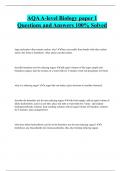
-
AQA A-level Biology paper 1 Questions and Answers 100% Solved
- Exam (elaborations) • 27 pages • 2024
- Available in package deal
-
- £12.21
- + learn more
AQA A-level Biology paper 1 Questions and Answers 100% Solved large molecules often contain carbon. why? they can readily form bonds with other carbon atoms. this forms a 'backbone'. other atoms can then attach. describe benedicts test for reducing sugars add equal volumes of the sugar sample and benedicts reagent. heat the mixture in a water bath for 5 minutes. brick red precipitate will form. what is a reducing sugar? a sugar that can reduce (give electrons to) another chemical. des...
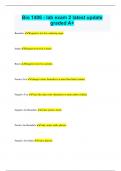
-
Bio 1406 - lab exam 2 latest update graded A+
- Exam (elaborations) • 12 pages • 2024
- Available in package deal
-
- £8.13
- + learn more
Bio 1406 - lab exam 2 latest update graded A+ Benedicts Reagent to test for a reducing sugar Iodine Reagent to test for a starch Biuret Reagent to test for a protein Positive Test changes colors (benedicts) or turns blue-black (iodine) Negative Test stays the same color (benedicts) or turns amber (iodine) Negative for Benedicts water, potato, starch Positive for Benedicts soda, onion, milk, glucose Negative for Iodine water, glucose Positive for Iodine cornstarch ...
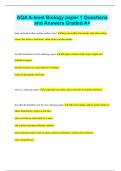
-
AQA A-level Biology paper 1 Questions and Answers Graded A+
- Exam (elaborations) • 33 pages • 2024
- Available in package deal
-
- £8.53
- + learn more
AQA A-level Biology paper 1 Questions and Answers Graded A+ large molecules often contain carbon. why? they can readily form bonds with other carbon atoms. this forms a 'backbone'. other atoms can then attach. describe benedicts test for reducing sugars add equal volumes of the sugar sample and benedicts reagent. heat the mixture in a water bath for 5 minutes. brick red precipitate will form. what is a reducing sugar? a sugar that can reduce (give electrons to) another chemical. descr...
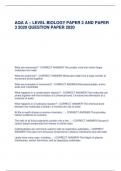
-
AQA A – LEVEL BIOLOGY PAPER 2 AND PAPER 3 2020 QUESTION PAPER 2020
- Exam (elaborations) • 29 pages • 2023
- Available in package deal
-
- £10.17
- + learn more
AQA A – LEVEL BIOLOGY PAPER 2 AND PAPER 3 2020 QUESTION PAPER 2020 What are monomers? - CORRECT ANSWER-The smaller units from which larger molecules are made What are polymers? - CORRECT ANSWER-Molecules made from a large number of monomers joined together What are examples of monomers? - CORRECT ANSWER-Monosaccharides, amino acids and nucleotides What happens in a condensation reaction? - CORRECT ANSWER-Two molecules are joined together with the formation of a chemical bond, it invol...
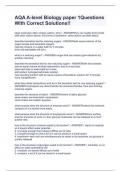
-
AQA A-level Biology paper 1Questions With Correct Solutions!!
- Exam (elaborations) • 14 pages • 2024
- Available in package deal
-
- £10.58
- + learn more
large molecules often contain carbon. why? - ANSWERthey can readily form bonds with other carbon atoms. this forms a 'backbone'. other atoms can then attach. describe benedicts test for reducing sugars - ANSWERadd equal volumes of the sugar sample and benedicts reagent. heat the mixture in a water bath for 5 minutes. brick red precipitate will form. what is a reducing sugar? - ANSWERa sugar that can reduce (give electrons to) another chemical. describe the benedicts test for non red...
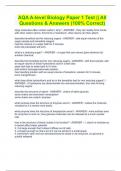
-
AQA A-level Biology Paper 1 Test || All Questions & Answers (100% Correct)
- Exam (elaborations) • 15 pages • 2024
- Available in package deal
-
- £9.77
- + learn more
AQA A-level Biology Paper 1 Test || All Questions & Answers (100% Correct) AQA A-level Biology Paper 1 Test || All Questions & Answers (100% Correct) large molecules often contain carbon. why? - ANSWER - they can readily form bonds with other carbon atoms. this forms a 'backbone'. other atoms can then attach. describe benedicts test for reducing sugars - ANSWER - add equal volumes of the sugar sample and benedicts reagent. heat the mixture in a water bath for 5 minutes. brick red prec...
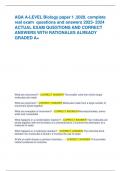
-
AQA A-LEVEL Biology paper 1 .2020. complete real exam questions and answers 2023- 2024 ACTUAL EXAM QUESTIONS AND CORRECT ANSWERS WITH RATIONALES ALREADY GRADED A+
- Exam (elaborations) • 29 pages • 2023
- Available in package deal
-
- £9.76
- + learn more
AQA A-LEVEL Biology paper 1 .2020. complete real exam questions and answers ACTUAL EXAM QUESTIONS AND CORRECT ANSWERS WITH RATIONALES ALREADY GRADED A+ What are monomers? - CORRECT ANSWER-The smaller units from which larger molecules are made What are polymers? - CORRECT ANSWER-Molecules made from a large number of monomers joined together What are examples of monomers? - CORRECT ANSWER-Monosaccharides, amino acids and nucleotides What happens in a condensation reaction? - CORRECT AN...
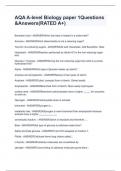
-
AQA A-level Biology paper 1Questions &Answers(RATED A+)
- Exam (elaborations) • 14 pages • 2024
- Available in package deal
-
- £10.66
- + learn more
Benedict's test - ANSWERWhich food test is heated in a water bath? Sucrose - ANSWERWhich disaccharide is not a reducing sugar? Test for non-reducing sugars - ANSWERAdd acid. Neutralise. Add Benedicts. Heat. Hydrolysis - ANSWERReaction performed by dilute HCl in the non reducing sugar test. Glucose + fructose - ANSWERDuring the non-reducing sugar test what is sucrose hydrolysed into? Alpha - ANSWERWhich type of glucose makes up starch? amylose and amylopectin - ANSWERNames of t...
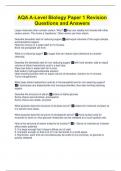
-
AQA A-Level Biology Paper 1 Revision Questions and Answers
- Exam (elaborations) • 15 pages • 2024
- Available in package deal
-
- £8.13
- + learn more
Large molecules often contain carbon. Why? they can readily form bonds with other carbon atoms. This forms a 'backbone'. Other atoms can then attach. Describe benedicts test for reducing sugars add equal volumes of the sugar sample and benedicts reagent. Heat the mixture in a water bath for 5 minutes. Brick red precipitate will form. What is a reducing sugar? a sugar that can reduce (give electrons to) another chemical. Describe the benedicts test for non reducing sugars with food s...

How did he do that? By selling his revision notes on Stuvia. Try it yourself! Discover all about earning on Stuvia


